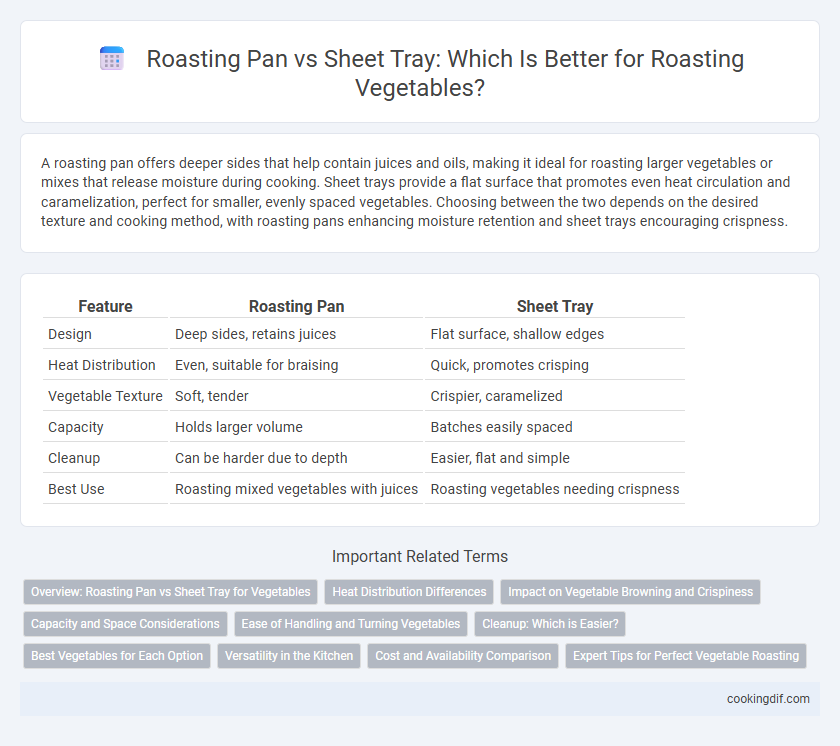A roasting pan offers deeper sides that help contain juices and oils, making it ideal for roasting larger vegetables or mixes that release moisture during cooking. Sheet trays provide a flat surface that promotes even heat circulation and caramelization, perfect for smaller, evenly spaced vegetables. Choosing between the two depends on the desired texture and cooking method, with roasting pans enhancing moisture retention and sheet trays encouraging crispness.
Table of Comparison
| Feature | Roasting Pan | Sheet Tray |
|---|---|---|
| Design | Deep sides, retains juices | Flat surface, shallow edges |
| Heat Distribution | Even, suitable for braising | Quick, promotes crisping |
| Vegetable Texture | Soft, tender | Crispier, caramelized |
| Capacity | Holds larger volume | Batches easily spaced |
| Cleanup | Can be harder due to depth | Easier, flat and simple |
| Best Use | Roasting mixed vegetables with juices | Roasting vegetables needing crispness |
Overview: Roasting Pan vs Sheet Tray for Vegetables
Roasting pans provide deeper sides and better heat retention, making them ideal for evenly cooking vegetables with juices and oils. Sheet trays offer a flat surface that promotes airflow and caramelization, resulting in crispier edges and faster roasting. Choosing between a roasting pan and a sheet tray depends on desired texture and cooking technique for vegetables.
Heat Distribution Differences
Roasting pans feature higher sides that promote even heat circulation and moisture retention, ensuring vegetables cook uniformly without drying out. Sheet trays provide a larger, flat surface area that allows for better caramelization and crispiness, although heat may distribute less evenly on thicker or denser vegetables. Choosing the right tool depends on the desired texture and roasting method, with roasting pans excelling in gentle, consistent heat and sheet trays ideal for high-heat, crispy results.
Impact on Vegetable Browning and Crispiness
A roasting pan with higher sides traps steam, which can reduce the browning and crispiness of vegetables by preventing moisture from escaping. In contrast, a sheet tray's flat surface allows better air circulation and moisture evaporation, promoting even caramelization and a crispier texture. Choosing a sheet tray over a roasting pan enhances the Maillard reaction, resulting in more flavorful, golden-brown roasted vegetables.
Capacity and Space Considerations
Roasting pans typically offer deeper capacity, allowing vegetables to roast evenly without overcrowding, which prevents steaming and promotes caramelization. Sheet trays provide a larger flat surface area, ideal for spreading vegetables in a single layer to maximize air circulation and crispiness. Choosing between the two depends on the volume of vegetables and available oven space, with roasting pans suited for smaller batches and sheet trays preferable for larger quantities.
Ease of Handling and Turning Vegetables
A roasting pan with high sides offers better containment and easier turning of vegetables without spillage, making it ideal for evenly roasting varied cuts. Sheet trays provide a flat, open surface, allowing vegetables to roast with more direct heat and crispiness, but require careful handling to prevent spilling when turning. Choosing between the two depends on vegetable quantity and desired texture, with roasting pans excelling in ease of handling and sheet trays in achieving crisp edges.
Cleanup: Which is Easier?
Roasting pans with nonstick surfaces or removable racks often allow juices and charred bits to collect in a confined area, simplifying cleanup compared to sheet trays. Sheet trays typically have a flat surface, causing oils and food residue to spread over a larger area, which can require more scrubbing. Choosing a roasting pan made of stainless steel or with a nonstick coating generally results in easier cleanup after roasting vegetables.
Best Vegetables for Each Option
Roasting pans provide even heat distribution and deep sides, making them ideal for vegetables like hearty root crops--carrots, potatoes, and beets--that benefit from slow, uniform roasting and retaining natural moisture. Sheet trays offer a flat surface with more airflow, perfect for quick-roasting vegetables such as asparagus, bell peppers, and zucchini, which caramelize better with direct heat exposure. Choosing the right vessel enhances texture and flavor, emphasizing caramelization on lighter vegetables or succulence on denser varieties.
Versatility in the Kitchen
Roasting pans offer deep sides ideal for cooking meats and vegetables with juices, making them versatile for braises and roasts. Sheet trays provide a flat, open surface perfect for evenly roasting vegetables, promoting caramelization and crisp texture due to maximum air exposure. Choosing between a roasting pan and sheet tray depends on the cooking method and desired vegetable texture, with trays excelling in high-heat roasting and pans supporting more liquid-based recipes.
Cost and Availability Comparison
Roasting pans typically cost more than sheet trays due to their heavier construction and specialized design for even heat distribution. Sheet trays are more widely available and generally less expensive, making them a budget-friendly option for roasting vegetables. While roasting pans offer durability, sheet trays provide greater accessibility and affordability for everyday cooking.
Expert Tips for Perfect Vegetable Roasting
Selecting a roasting pan with elevated sides ensures even heat distribution and prevents vegetables from drying out, while a sheet tray promotes optimal caramelization by allowing steam to escape. Expert tips recommend spacing vegetables evenly on a sheet tray to maintain crispness and using a roasting pan for denser vegetables to retain moisture. For perfect roasted vegetables, choosing the right vessel based on vegetable type enhances texture and flavor complexity.
Roasting pan vs Sheet tray for vegetables Infographic

 cookingdif.com
cookingdif.com